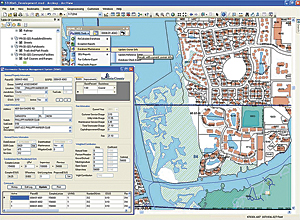Storm Water Revenue Management System
A GIS-Centric Solution for Managing Nonspatial Tax Revenue Databases
By James Crandall, Independent GIS Consultant
Highlights
- ArcGIS provides a powerful information management system with improved customer service.
- The revenue management application does not require the user to be an expert in GIS.
- The county GIS and property appraiser's office coordinate their efforts to maintain parcel and attribute data.
Sarasota County is located in the southwest portion of the state of Florida. The area is known for its pristine coastal beaches; according to the Los Angeles Times, Sarasota's Siesta Beach was ranked no. 1 of the top 10 beaches in the entire United States in 2011. While the typical beach characteristics are important contributors that determine what a great beach should be, certainly a vital characteristic is the quality of the water itself, and the Sarasota County government takes the water management task very seriously.

The main user interface of the Stormwater Revenue Management System integrated with ArcGIS 10. Assessment information display, management, and reporting are all performed with ArcGIS.
Since 1998, the Sarasota County Stormwater Management department has been in charge of providing funding for long-range planning and capital improvements for properly planned, constructed, and maintained storm water runoff utility infrastructure. The department has been committed to providing responsive service to its customers with the maintenance, repair, operation, and improvement of the public storm water utility system, which consists of the storm water infrastructure itself (culverts, drainage assets, etc.).
Excessive rainwater runoff that goes unmanaged can cause serious water quality and flooding problems, and it is the responsibility of Sarasota County Stormwater Utility to manage the infrastructure to maintain good water quality that, in turn, contributes to the continued beauty of the area's beaches.
Funding to Maintain the Vital System
To acquire its funding, the Stormwater Management department accumulates revenue through the assessment of taxation to each property owner within the storm water assessment area, a process that required some type of information management system. Each fiscal year, residents receive a notice of their assessment due. An effective information system is necessary to not only maintain accurate tax assessment information that is relevant to Stormwater Utility but also fulfill the task of collecting that revenue.
Typically, this kind of information is not spatial and is ancillary to the larger GIS infrastructure, yet the data is related in a significant way to spatial data that many county-level governments maintain: parcel data.
Parcel layer information that is maintained by Sarasota County GIS and the county Property Appraiser's Office is related to storm water assessment information by way of parcel identification numbers. It is this relationship that allows the inherently nonspatial storm water tax assessment information to be viewed and managed with ArcGIS software, which in turn allowed the development of the county's Stormwater Revenue Management System (SRMS).
Database Design and Application Development
Bringing it all together in one map display has been critical to smarter data management. Previously, the county had been using Microsoft Access as a database to manage the assessment information. This was migrated to an enterprise database solution, Microsoft's SQL Server 2008, and placed on the county GIS division's servers, alongside the other ArcSDE databases it maintains. This architecture allows seamless integration between the SRMS and the parcel data within the map space of ArcGIS. Additionally, the SRMS application does not require the user to be an expert in the use of GIS to manage the entire storm water tax assessment database.
ArcGIS is a good choice for a front-end software solution because the storm water data itself is really a collection of complex attributes of parcel data. Sarasota County GIS and the Sarasota County Property Appraiser's Office coordinate their efforts to maintain this parcel and attribute data, and GIS is a logical tool for managing the nonspatial data contained in the SRMS database. Users greatly benefit from the spatial characteristics of the parcel data, which provides a way for them to actually visualize their entire assessment database.
Several benefits were immediately realized. The storm water technician in charge of managing the assessment information only needs to know some basic operation of GIS (such as pan, zoom, identify, area calculator) yet has the ability to administer every aspect of the SRMS database right from the single map display. For example, the user can enter a parcel identification number and click a button, and this will query, select, and zoom to the parcel. Another menu option allows the user to pull up all related storm water assessment information, make changes, and save those changes. Technicians can use the ArcGIS area calculator to determine attributes, such as impervious area of a parcel; recalculate assessment rates and fees; and submit the updated assessment back to the SRMS database.
Additionally, assessment information for entire condominium complexes can be maintained right from the GIS. This kind of data management had been very difficult to achieve in the past, but because the system is now integrated with the GIS infrastructure, the one-to-many relationship that exists between a single parcel and its many related condominium units is being utilized fully to process the information.
Typical Tax Revenue Databases
Tax assessment databases are unique across levying districts because they must be synchronized with the entire county's tax roll database, which is normally administered by the county's Property Appraiser's Office. In other words, real estate property can be bought, sold, split, combined, and changed on a daily basis, and any ancillary databases, such as a tax assessment database, must be synced with these changes. This is especially important to complete prior to reporting of the assessments at the end of each fiscal year. The timing of this syncing process is critical, because a large amount of data can become unfounded in a short amount of time, especially during times of high real estate transactions.
What Does It All Mean?
With the GIS-centric approach of SRMS and the new tools that have been implemented, the data management occurs daily and is performed by a single storm water technician. The ability to visualize nonspatial storm water assessment information in ArcGIS provides a powerful information management system that ultimately leads to better customer service and facilitates the acquisition of revenue.
About the Author
James Crandall is an independent GIS, .NET, and SQL Server developer. He has performed GIS development work for Sarasota County government since 2001 for various departments, from Stormwater Management to Mosquito Management Services. He graduated with a bachelor's degree in geography from Florida Atlantic University, Boca Raton, Florida, in 1998.
For more information, contact Evan Brown, enterprise GIS manager, Sarasota County Government (e-mail: ebrown@scgov.net), or James Crandall (e-mail: james@javitechnologies.com, tel.: 941-815-1739).
